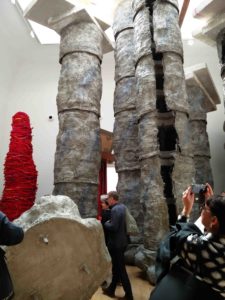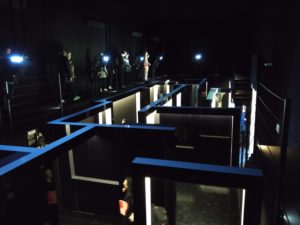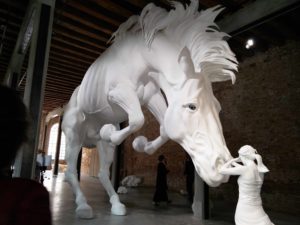13 May – 26 November 2017
In our first article, we focussed on the structure of the main exhibition “VIVA ARTE VIVA” of the 57. Biennale di Venezia. Now we like to present three of the 86 National Participations that refer in one or the other way to space.
Phyllida Barlow: folly
Curated by Delphine Allier & Harriet Cooper
The British Pavilion is greeting from far away since the sculptures by Phyllida Barlow are not only occupying the inside of the building, but have conquered as well the balcony and the edges besides the stairs. The coloured “baubles” are unshaped objects speared on bars. They appear to wait for entrance to the edifice. However, they will not get in; because the first hall is filled with oversized grey and red columns, some seem to blaster the rooftop. Furthermore, there are more baubles; this time in grey and in a row like on a skewer and other elements. Despite their monumentality, the columns occur light-weighted, since they have a torn gab in the middle of them, revealing structure.
All this sculptures take possession of the space. They inhabit it and leave little space to stroll around them. Barlow wanted to explore the space with physical stuff, to create a relationship with the space. Now the audience, in her opinion the other performers, should explore the installation crawling through the sculptures. The artist stated that she hopes her work is a theatrical encounter. It succeeded.
Choosing the title “folly” Barlow thought of folly in the sense foolhardy, risky, stupid and as well as a building with no other function than to be decorative. Consequently, she questions the definition of sculptures: Are they a collection of redundant things? Do they know, where they meant to be? Have they associations or metaphors? Are they in a way phantoms or premonitions of objects? Are they dreams or memories? It is up to the visitor to adopt a proper interpretation.
https://venicebiennale.britishcouncil.org/2017-exhibition/phyllida-barlow
George Drivas: Laboratory of Dilemmas
Curated by Orestis Andreadakis
Even though based on one of the oldest handed down Greek plays – “The Suppliants” (Ἱκέτιδες) – the Laboratory of Dilemmas features present global problems like asylum, foreign infiltration, human rights and conflict management. In short, topics, which occur, when people are crossing spaces.
“The Suppliants” by Aeschylus written after 466 B.C. could be the first drama ever, which raises the issue of asylum: 50 women, the Suppliants, flee from Egypt, avoiding the marriage to their cousins and ask the king of Argos to give them shelter. The King faces the dilemma between disturbances for his people concerning their fear about the strangers and a possible war with Egypt or the decision to offer hospitality and protection against the pursuing husbands.
George Drivas transfers the dilemma into the 1960s, by documentary seeming videos. The one to two minutes long films show scientists, discussing the direction of a failed experiment to design cells against hepatitis. Towards the end of the project, appear new cells different from the ones investigated. Well-known Greek actors and Charlotte Rampling in a leading role discuss how to continue the research: kill the new cells to avoid a possible not controllable propagation or pursue the experiment with the new cells in the hope to find a substance against hepatitis.
In translating the subject into a scientific context, the visitor might get the impression to find an answer to the ethical and moral conflict by a rational approach. Nevertheless, even the natural scientists entrap into the dilemma. Even the video of the final discussion (10 min) does not offer an answer to a right decision: it stops at the most critical moment. The dilemma remains unresolved.
Laboratory of Dilemmas is a narrative video installation, which enables the visitor not only to follow the conflict through the films, but also to capture it physically at the same time. On the upper level is a surrounding corridor. Here six films are shown on small screens in a loop. In parallel, the visitor can glimpse onto the labyrinth on the lower level. Descending here, one goes through the passages, listening to five audio recordings, reproducing the researcher’s conversation held at the moment of the detection of the new cells. The irritation about the discovery is underlined by lack of clarity inherent to structure, reinforced by the subdued light. Even the last video in the screening room at the end of the labyrinth gives no clarification. This is intended by the artist, who does not want to be instructive, but to point on the dilemma and makes it perceptible in the space.
http://greeceatvenice.culture.gr
http://laboratoryofdilemmas.gr
Claudia Fontes: The Horse Problem
Curated by Andrés Duprat
Also Claudia Fontes Horse Problem interacts with the space, even though in a very different way as Phyllida Barlow and George Drivas. Fontes exploits the mammoth hall in the Arsenale by a monumental sculpture of a white horse. This is not only related to the development of the Argentinian cultural identity, but as well to the history of the building. For the construction of the Arsenale, starting in the 12th century enormous masses of wood, bricks and iron had to be moved by horsepower. Even long before, horses were domesticated and the relation between human and animal determined.
Similar to the exploitation of horses, the conquerors of America proceeded when they arrived in the new world: they took everything they could from the soil and the indigenous people. This is another link to the architectural complex of the Arsenale: it was used for shipbuilding and as armoury for the Venetian Republic, the fundament for the Venice expansion. So the Arsenale became the first place of industrial production long before the Industrial Revolution and with that, a model for the later colonising Nations.
In consequence of the colonisation, Argentina and the other Latin American countries had a late nation building in comparison to the European States. Only in 1892, the first commissioned artwork was painted to represent Argentina culturally as a nation at the world’s fair in Chicago to celebrate the fourth century of Columbus’ arrival in the new world. “The Return of the Indian Raid” by Ángel Della Valle shows one of the numerous Indian raids to the European settlers, a result of the violent conquest of lands from indigenous people by the state. Ángel Della Valle’s painting can be seen as an instrument of political propaganda to justify the suppression of the natives.
Claudia Fontes isolates two of the depicted figures: the white horse and the kidnapped white woman. Both dominated by others in the painting, interact now showing the possibility of another relationship between human and animal. Menacing rocks all around are disturbing the harmonious scene. They leave their shadows like the past impacts the present. A young man, perched on the floor, contemplates one of the stones in his hand. Is he reflecting about the necessity of all the obstacles in the way to peaceful coexistence?
With the monumental installation Fontes criticises nationalism, the one that led to colonisation, the one practised in the nation building and the one still existing, inter alia by the Biennale’s structure of national representations. It could be read as a suggestion to find alternative modes of behaviour for the future.




























